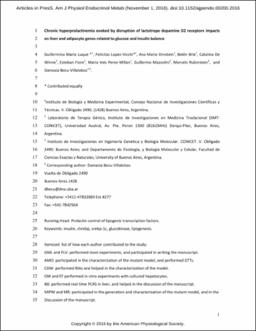Chronic hyperprolactinemia evoked by disruption of lactotrope dopamine D2 receptors impacts on liver and adipocyte genes related to glucose and insulin balance.

View/
Date
2016-11-01Author
Luque, Guillermina.
Lopez-Vicchi, Felicitas.
Ornstein, Ana M.
Brie, Belén.
De Winne, Catalina.
Fiore, Esteban.
Mazzolini, Guillermo.
et al.
Metadata
Show full item recordAbstract
We studied the impact of high prolactin titers on liver and adipocyte gene expression related to glucose and insulin homeostasis in correlation with obesity onset. To that end we used mutant female mice that selectively lack dopamine type 2 receptors (D2Rs) from pituitary lactotropes (lacDrd2KO), which have chronic high prolactin levels associated with increased body weight, marked increments in fat depots, adipocyte size, and serum lipids, and a metabolic phenotype that intensifies with age. LacDrd2KO mice of two developmental ages, 5 and 10 mo, were used. In the first time point, obesity and increased body weight are marginal, although mice are hyperprolactinemic, whereas at 10 mo there is marked adiposity with a 136% increase in gonadal fat and a 36% increase in liver weight due to lipid accumulation. LacDrd2KO mice had glucose intolerance, hyperinsulinemia, and impaired insulin response to glucose already in the early stages of obesity, but changes in liver and adipose tissue transcription factors were time and tissue dependent. In chronic hyperprolactinemic mice liver Prlr were upregulated, there was liver steatosis, altered expression of the lipogenic transcription factor Chrebp, and blunted response of Srebp-1c to refeeding at 5 mo of age, whereas no effect was observed in the glycogenesis pathway. On the other hand, in adipose tissue a marked decrease in lipogenic transcription factor expression was observed when morbid obesity was already settled. These adaptive changes underscore the role of prolactin signaling in different tissues to promote energy storage.

